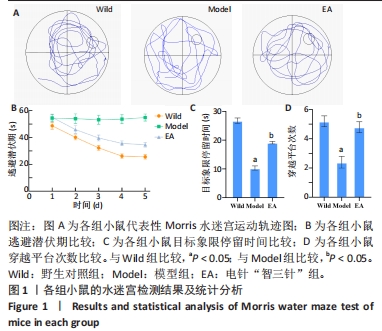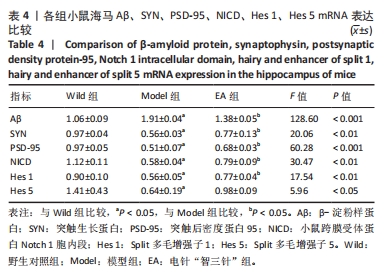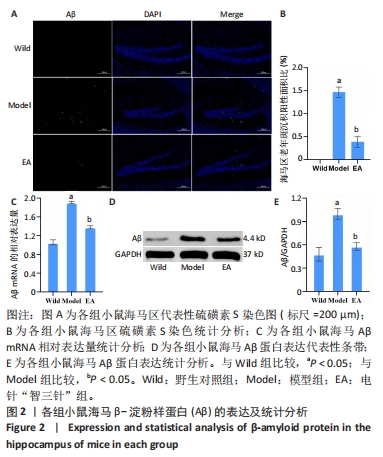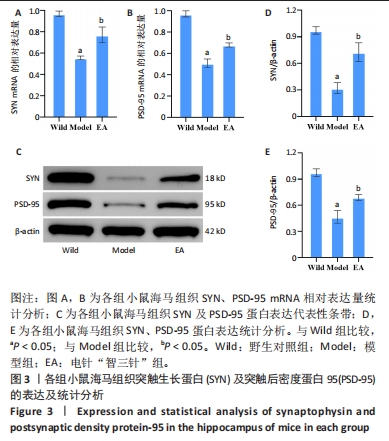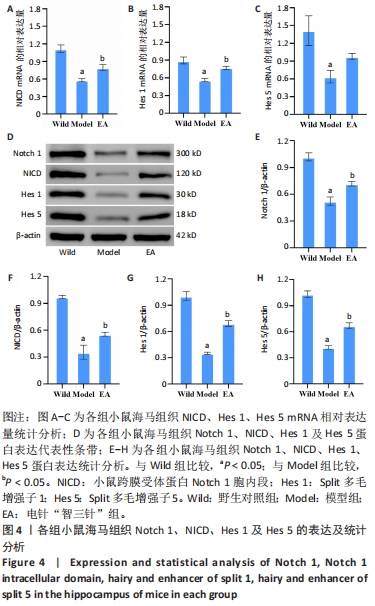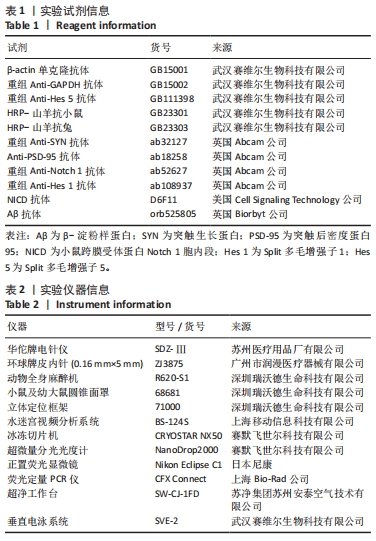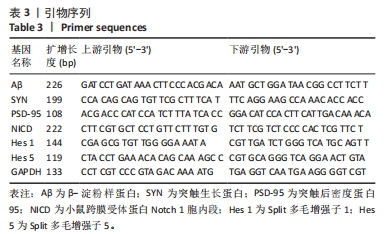中国组织工程研究 ›› 2024, Vol. 28 ›› Issue (32): 5148-5153.doi: 10.12307/2024.507
• 组织构建实验造模 experimental modeling in tissue construction • 上一篇 下一篇
电针“智三针”对5xFAD小鼠Notch信号通路及突触可塑性的影响
温华能1,2,林 润3,王逸潇3,王冰水1,刘 璐1,刘传耀1,蔡灿鑫1,崔韶阳3,许明珠1
- 1南方医科大学深圳医院康复医学科,广东省深圳市 518101;2南方医科大学第三临床医学院,广东省深圳市 518101;3广州中医药大学深圳医院(福田)康复医学科,广东省深圳市 518034
Effects of electroacupuncture with “Zhi San Zhen” on Notch signaling pathway and synaptic plasticity in 5xFAD mice
Wen Huaneng1, 2, Lin Run3, Wang Yixiao3, Wang Bingshui1, Liu Lu1, Liu Chuanyao1, Cai Canxin1, Cui Shaoyang3, Xu Mingzhu1
- 1Department of Rehabilitation Medicine, Shenzhen Hospital, Southern Medical University, Shenzhen 518101, Guangdong Province, China; 2The Third Clinical Medical College of Southern Medical University, Shenzhen 518101, Guangdong Province, China; 3Deparment of Rehabilitation Medicine, Shenzhen Hospital (Futian), Guangzhou University of Chinese Medicine, Shenzhen 518034, Guangdong Province, China
摘要:
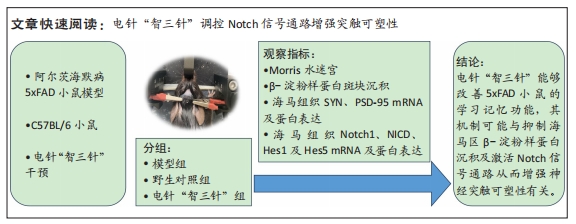
文题释义:
5xFAD小鼠:携带人类遗传性早发性家族性阿尔茨海默病(Familial Alzheimer’s Disease,FAD)相关基因突变,包括5个不同突变点(3个在APP基因上,2个在PS1基因上),因此得名为5xFAD。这些基因突变导致小鼠产生异常的β-淀粉样蛋白,β-淀粉样蛋白的异常聚集形成斑块沉积,而β-淀粉样蛋白斑块的形成与阿尔茨海默病的发病机制密切相关。因此,研究5xFAD小鼠可以更好地了解阿尔茨海默病的病理过程,并寻找治疗该疾病的新方法和靶点。Notch信号通路:是一种高度保守的细胞间相互作用途径,在神经系统发育、干细胞的自我更新、免疫系统发育等多个生理和病理过程中发挥重要作用。Notch信号通路激活可以促进突触形成,因此,调节Notch信号通路可能为神经系统疾病的治疗带来新的希望。
背景:阿尔茨海默病是以认知功能障碍为主要临床表现的退行性神经系统疾病,针刺是治疗阿尔茨海默病的传统特色疗法,但作用机制尚不明晰。
目的:观察电针“智三针”对5xFAD小鼠Notch信号通路、β-淀粉样蛋白及突触可塑性的影响。方法:将16只SPF级、雄性、6月龄5xFAD小鼠随机分为电针“智三针”组和模型组,每组8只,另取8只同条件C57BL/6小鼠作为野生对照组。电针“智三针”组进行电针“智三针”干预,每周5次,连续4周;模型组、野生对照组不进行干预。干预结束后,采用Morris水迷宫初步评价学习记忆能力;硫磺素S染色检测β-淀粉样蛋白斑块沉积情况;Western blot和qPCR检测跨膜受体蛋白Notch 1、Notch 1胞内段(Notch 1 intracellular domain,NICD)、Split多毛增强子1(hairy and enhancer of split 1,Hes 1)、Split多毛增强子5(hairy and enhancer of split 5,Hes 5)、突触生长蛋白(synaptophysin,SYN)、突触后密度蛋白95(postsynaptic density protein-95,PSD-95)及β-淀粉样蛋白的表达水平。
结果与结论:①与模型组相比,野生对照组、电针“智三针”组小鼠逃避潜伏期缩短,穿越平台次数及目标象限停留时间增加(P < 0.05);②与野生对照组相比,模型组小鼠海马区β-淀粉样蛋白斑块沉积显著增加,而电针“智三针”抑制了β-淀粉样蛋白斑块沉积(P < 0.05);③与野生对照组相比,模型组小鼠海马组织中SYN、PSD-95、Notch 1、NICD、Hes 1及Hes 5 mRNA表达降低,β-淀粉样蛋白mRNA表达增加(P < 0.05);与模型组相比,电针“智三针”组SYN、PSD-95、Notch 1、NICD、Hes 1及Hes 5 mRNA表达升高,β-淀粉样蛋白mRNA表达降低(P < 0.05);④与野生对照组相比,模型组小鼠海马组织中SYN、PSD-95、Notch 1、NICD、Hes 1及Hes 5蛋白表达降低,β-淀粉样蛋白表达增加(P < 0.05),与模型组相比,电针“智三针”组SYN、PSD-95、Notch 1、NICD、Hes 1及Hes 5蛋白表达增加,β-淀粉样蛋白表达降低(P < 0.05);⑤结果表明,电针“智三针”能够改善5xFAD小鼠的学习记忆功能,其机制可能与抑制海马区β-淀粉样蛋白沉积及激活Notch信号通路从而增强神经突触可塑性有关。
https://orcid.org/0000-0003-0467-6086(许明珠)
中国组织工程研究杂志出版内容重点:组织构建;骨细胞;软骨细胞;细胞培养;成纤维细胞;血管内皮细胞;骨质疏松;组织工程
中图分类号:
